
Health Seeking Behaviour in Stress Management A Case Study of French Tourist Community in Kangra, Himachal Pradesh
*Corresponding Author(s):
Ram Babu SinghDepartment Of Geography, Delhi School Of Economics, University Of Delhi, New Delhi, India
Tel:+91 8629837685,
Email:rbsgeo@hotmail.com
Abstract
Various studies have demonstrated that stress originates severe health problems and disturbs the normal metabolism. Health seeking behaviour of people in India is closely interwoven in the diverse geography and socio-cultural background. Codified system of ayurveda possesses symbiotic relation with the medical lore and acknowledges social and ecological factors along with mental makeup of the patient. It is technical but not reductionist and provides a meticulous account of the endemic flora-fauna and the changes in environment that could affect health. The study aims at evaluating the cause and stress management strategies among the medical tourists of France who visited Kangra in Himachal Pradesh for ayurvedic treatment during April 2015 to December 2015. The case study is set out to investigate the relational and individual benefits of Ayurvedic treatment in combating stress among French tourist community at Namlang Himal Health Resort situated at Bir village of Kangra district of Himachal Pradesh. Purposive sampling technique is used to select (N = 25) French tourists using both qualitative and quantitative data. The results indicate the benefits of the Ayurvedic treatment along with natural diet among medical tourists. Lack of concentration, loneliness, Insomnia and elevated blood pressure were experienced by 93 per cent, 92 per cent, 90 per cent and 45 per cent of the French tourists respectively. Anxiety, frustration, depression and impatience are some emotional stress felt by approximately 45 to 82 per cent of the respondents. Overall the medical tourists have shown significantly reduced psychological distress, physical and emotional stress. About 50 per cent reported excellent results and rest reported the treatment as satisfactory. The current case study provides reducing stress and enhancing psychological well-being in the sample. Integrated medical system (inclusion of modern and ayurvedic health systems together) is the need of the hour to combat lifestyle disease as well as promote medical tourism in hill region of Kangra.
Keywords
INTRODUCTION
The health issues arise when there is an imbalance between an individual and environment; these imbalances include abilities and demands, needs and opportunities, goals and actualities, desires and resources, reality and fantasy [1]. While dwelling specifically on Indigenous Knowledge and the age old system of Healing Practices, it may relevantly be noted that disease and health have been one of the fundamental concerns of man since times immemorial. Every society has developed its own responses and methods for coping up with diseases and ailments; and eventually a body of its own medical system whereas the economic and time considerations of modern medical health care delivery often limit doctors’ capacity to address the spiritual and emotional needs of their patients [2]. Presently 50 percent of the health burden is due to non-communicable diseases such as cardiovascular diseases, diabetes mellitus, hypertension, depression, obesity, stroke, cancer etc. Sedentary lifestyle, diet, obesity, lack of exercise, and stress are contributing factors in the causation. Stress has been observed as worldwide epidemic throughout the world and about 90 per cent of visit to physicians have been associated with it. It has detrimental impact on the physical, emotional and psychological wellbeing of an individual. Various studies have reported stress as the most common health problems caused due to long working hours and overburden of work. Anxiety, frustration, anger and feelings of inadequacy, helpless or powerlessness are emotions often associated with stress. Stress is derived from the word “stringere” which means “to be drawn tight”. Stress can be defined as a physical or psychological stimulus that can produce tension or physiological reactions that may lead to illness [3].
NICHE (MEDICAL) TOURISM: AYURVEDA AND YOGA (DRUGLESS THERAPY)
India with 1.25 billion people are served by merely 4.5 million doctors and thus health inequity exists. Here the doctor to patient ratio is one per 1,200 [4]. Indigenous healing rooted inexperience is still important in regions where bio - medicine may be too expensive or inaccessible. People are particularly interested to experience health benefits and rural tourism due to calm weather, lush green forests and peace. Studies on tourism suggest that tourism industry can also help promote peace and stability in developing country like India by providing jobs, generating income, diversifying the economy, protecting the environment, indigenous health services and promoting cross - cultural awareness [5]. Herbs, health, tourism and rural livelihood have always been inter linked and provide promising future. The popularity of traditional healing system has increased considerably in the past one decade. The demand from the urban population and developed world had alarmingly increased the over - exploitation of forest resources. The impact of globalization on indigenous cultures and traditional health practices can be seen as the increasing interplay of cultures. Holistic and preventive healthcare has received global acceptance where the focus is on wellness culture. Dharamsala (Kangra) has become a potential destination for ayurveda and yoga tourism and the ecology with diversified forms of health care system called Complementary and Alternative Medicine (CAM). It is remarkable that Complementary and Alternative Medicine (CAM) is used by one out of two European Union citizens. Throughout the European Union people are evidently seeking natural methods of healing and increasingly favors the provision of CAM within existing healthcare systems of Europe (Figure 1a and 1b), [6]. Indian Himalaya has always been a source of ayurveda since time immemorial. During last couple of years, the rapid erosion of traditional knowledge and medicinal plants is noticed. At the same time, the growing globalization of ayurveda and herbal medicine is also in fire. The study aims at determining the cause and stress management strategies among the medical tourists of France who visited Kangra for ayurvedic treatment during April 2015 to December 2015. 25 French tourists from Namlang Himal Health Resort situated at Bir, Baijnath block of Kangra district in Himachal Pradesh were selected. These tourists visit the resort for ayurvedic treatment as well as recreation and adventure sports events. Some are particularly interested to learn ayurveda and health rejuvenation techniques. Namlang Himal Health Resort is taken for this particular study purposefully because it is owned by French women of repute among tourists. French nationals prefer this place both for medical and recreational tourism.
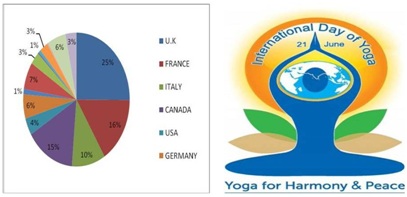
RESEARCH METHODOLOGY
Study area
Purposive sampling method has been used to select 25 French medical tourists from Namlang Himal resort. Semi-structured questionnaire is used to collect relevant data on the causes of stress, pre and post health history and their socio-economic background. Intensive research method, unstructured interview, ethnographic technique and case study have been used to analyse the health status of medical tourists. Health impact assessment was also done to reveal pre and post health status of the medical tourists. Descriptive and inferential statistics have been used to analyze the data using SPSS software and diagrams and tables are created using MS Excel. Factor analysis using SPSS is used to present significant group of herbs used in stress management.
RESULTS AND DISCUSSION
Results
Case study of Namlang Himal resort at Bir village
On an average INR 1,500 is spent by tourist son ayurvedic treatment. She promotes ayurveda in France as well as other countries by her unique resort based ayurveda service. On an average 80 tourists visit the resort every year since 2008 having slight decrease now due to Euro crisis. On an average, INR 1,000 is spent on food and accommodation in the resort except treatment. For instance in October 2015, individual visitor pays INR 15,000 for 15 days and for the month of October, total earning was INR 1,68,000. She has an innovative entrepreneurship and wants development of tourism in the Mid Himalaya region. Trekking should be promoted by the government efforts; there is an urgent need of lodges, restaurants and other facilities in the trekking routes. There is good demand from tourists but lack of proper planning in the region is the main bottleneck for untapped tourists place like Rajgunda (having lush green bed of grasses and surrounded by mountains), Barot Valley (fishing). There is also urgent need to protect the wildlife of the region.
French tourists have good paying capacity as 47 per cent had an income level between 50,000 - 0.1 million. Per day expenditure for medical tourists at Namlang Himal includes INR1,500 for Ayurvedic treatment, INR1,500 for food and accommodation at the same resort. From 25 visitors during October 2015, the resort on an average earned INR 70,000 - 75,000 per day. The visitors include both medical and paragliding tourists including students of ayurveda from France. 98 per cent of medical tourists were female. They were from various profession including doctors, nurses, and technical professionals. Recently in 2015, there held world paragliding, first ever in South Asia with participation of 130 pilots from 35 countries. This major event also attracts tourism in the region. The French tourists said that they come here due to calmness of place and all facilities at one place especially ayurveda treatment (Figures 2-6).
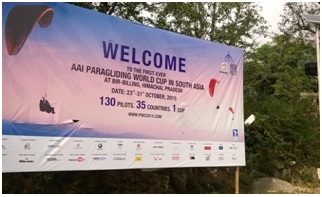
Figure 2: World Cup Pragliding at Bir, 2015. 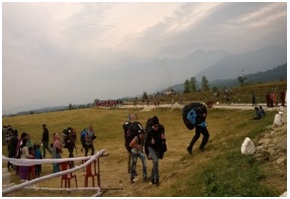
Figure 3: Paragliders at Bir, Kangra (Himachal Pradesh).
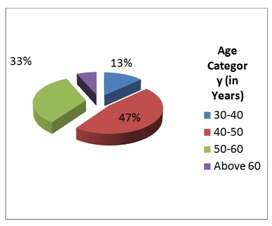
Figure 4: Age wise Per cent distribution of tourists.
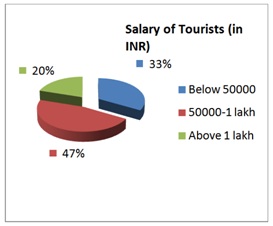
Figure 5: Income profile of medical tourist.
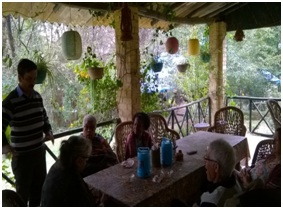
Socio-economic profile and health seeking behaviour of French tourists at Namlang Himal resort
90 per cent female mostly in the middle age group are suffering from stress, anxiety or other health issues due to occupation and marital status. Single female are more likely to suffer from stress and anxiety due to loneliness, and fear for future. Live in relationship is also considered by majority of the tourists as the cause of their stress. There is no sense of commitment in the relationship and thus emotional strength is missing from that particular relationship. Single women as well as men also feel burden of occupational stress like late working hours, aggressive work culture, target based results and overall fast pace of life. It result into insomnia (disturbed sleep), negative effect on biological cycle, body pain, headache, anxiety, depression etc. Psychological stress followed by loneliness (92 per cent) and Insomnia (90 per cent) are among the major types of stress suffered. Divorced female are also suffering from stress due to work pressure and excessive worries for their children. Psychological pressure is considered one of the major reasons for stress which varies from person to person. Release of emotional stress is better among female compared to males which helps in their health. Three out of sixteen are yoga instructors which show their inclination towards Indian traditional system of medicine. They consider yoga as drugless therapy which may also include natural products as diet therapy while performing yoga. The popularity of ayurvedic spas and yoga studios at France motivate them to feel the essence of the health system of another continent. They reported that there is huge lack of Indian system of medicine like ayurveda and yoga. They wish to receive original quality yoga and ayurveda and for that reason they visit India. Some of them also came to study ayurveda in order to popularize it in France.
In order to understand the health impact of ayurveda treatment pre and post case studies have been taken. Health and dietary habits are closely linked. Gradually it has been observed that non vegetarian diet increases cholesterol level as well as hard to digest which ultimately becomes the cause for several health issues. 100 per cent of them are non-vegetarian with majority of them on red meat. Their lifestyle is highly influencing their health status with late working hour. Irregular diet, fast food, irregular and late night sleep etc. are some of the major lifestyle pattern seen among the patients pre Ayurvedic treatment. Several diseases like PNS hypertrophy, acromegaly, arthritis Parkinson, low immunity and weakness are some major health challenges suffered by the patients. Their pre - ayurvedic treatment includes modern high dose medicine. Modern medicine and side effects are interrelated phenomena which were experienced by almost all patients. Long duration of treatment from modern medicine did not provide relief from health issues. Post Ayurvedic treatment is a combination of rejuvenation therapy, diet therapy, medicinal plants, yoga, Panchkarma and indigenous spa (Abhyanga, shirodhara, Shodhan etc.,). They were kept under full diet control which is the prime requirement of ayurveda to attain good health because ‘food is medicine’ as written in ayurvedic texts. Ginger honey lemon tea, boiled cereals and other herbs are included in their routine is fixed early in the morning till dinner by ayurvedic doctor at the resort. The ayurvedic doctor also reported that about 90 per cent patients (both male and female) cry hard after they go through the treatment and release their emotions due to soothing impact of the treatment which he considers good for their health. Patients also reported excellent experience of the ayurvedic treatment which they have never experienced earlier and they also promised to strictly follow the directions of the Ayurvedic doctor. After the completion of their treatment they are advised to take at least 6 months course of the Ayurvedic medicines which they happily agree and take away medicines with them (Table 1-4).
| Cause of Stress | Response (In per cent) |
| Unfriendliness in society | 65 |
| Relationship issues | 87 |
| Family issues | 56 |
| Occupational/work issues | 93 |
| Divorce | 90 |
| Multiple pressure including social, economic status | 46 |
| Types of Stress | Symptoms | Response (per cent) |
| Physical stress experienced | Backache, stiffness in neck | 59 |
| Elevated B.P. | 45 | |
| Insomnia | 90 | |
| Fatigue | 36 | |
| Emotional stress experienced | Depression | 82 |
| Loneliness | 92 | |
| Anxiety | 76 | |
| Over reaction | 23 | |
| Impatience | 45 | |
| Psychological stress | Excess smoking | 56 |
| Excess alcohol | 67 | |
| Lack of concentration | 93 | |
| Withdrawal | 87 |
| Case | Patient’s Gender | Age | Major Disease/symptom | Lifestyle | Dietary Habits | Treatment History/Other |
| 1 | Female | 45 | Stress | Late working hours | Non vegetarian | Modern medicine |
| 2 | Female | 48 | Arthritis | Late working hours | Non vegetarian | Modern medicine |
| 3 | Female | 32 | Constipation and irregular menstruation | Late working hours | Non vegetarian | Modern medicine |
| 4 | Male | 42 | PNS hypertrophy (Nasal problem) | Irregular working hours | Non vegetarian | Modern medicine |
| 5 | Female | 47 | Stress | Late working hours | Non vegetarian | Yoga and other |
| 6 | Female | 65 | Acromegaly (Abnormal growth) | Irregular working hours | Non vegetarian | Modern medicine |
| 7 | Female | 57 | Stress | Irregular eating habit | Non vegetarian | Exercise |
| 8 | Female | 57 | Obesity, stress | Irregular eating | Non vegetarian | Modern medicine |
| 9 | Female | 59 | Stress | Late working hours | Non vegetarian | Modern medicine |
| 10 | Male | 68 | Parkinson | Irregular eating habit | Non Vegetarian | Modern medicine |
| 11 | Female | 46 | Low immunity | Late working hours | Non vegetarian | Yoga |
| 12 | Female | 38 | Mineral deficiency, study* | Late working hours | Non vegetarian | Modern medicine |
| 14 | Female | 48 | Skin disease | Irregular eating habits | Non vegetarian | Modern medicine |
| 15 | Female | 47 | Stress, weight loss, | Late working hours | Non vegetarian | Modern medicine |
| 16 | Male | 55 | Weakness, stress | Irregular working hours | Non vegetarian | Modern medicine |
| Case | Patient’s Gender | Age | Major Disease/Symptom | AyurvedaTreatment | Duration of Treatment(in days) | Diet Change | Perception of Patients about Treatment |
| 1 | Female | 45 | Stress | Abhayang, shirodhara | 10 | Vegetarian, Diet therapy | Satisfactory |
| 2 | Female | 48 | Arthritis | Janubasti | 16 | Natural, Diet therapy | Excellent |
| 3 | Female | 32 | Constipation and irregular mensturation, study* | Virechanam/Purgation | 21 | Natural, Diet therapy | Excellent |
| 4 | Male | 42 | PNS hypertrophy(nasal problem) | NASYA | 21 | Strict diet therapy | Excellent |
| 5 | Female | 47 | Stress, study* | Rejuvenation | 30 | Natural products, Diet therapy | Excellent |
| 6 | Female | 65 | Acromegaly (Abnormal growth) | Diet therapy and treatment | 20 | Vegetarian, Diet therapy | Excellent |
| 7 | Female | 57 | Stress | Rejuvenation | 45 | Natural, Diet therapy | Satisfactory |
| 8 | Female | 57 | Obesity, stress | Udhvartan therapy | 21 | Natural, Diet therapy | Excellent |
| 9 | Female | 59 | Stress | Rejuvenation | 21 | Natural, Diet therapy | Excellent |
| 10 | Male | 68 | Parkinson | Internal basti | 20 | Natural, Diet therapy | Excellent |
| 11 | Female | 46 | Low immunity, study* | Rejuvenation | 15 | Natural, Diet therapy | Satisfactory |
| 12 | Female | 38 | Mineral deficiency, study* | Therapy | 30 | Natural, Diet therapy | Satisfactory |
| 13 | Female | 38 | Stress, study* | Rejuvenation | 30 | Natural, Diet therapy | Satisfactory |
| 14 | Female | 48 | Skin disease and stress | Various therapy | 30 | Natural, Diet therapy | Below Satisfactory |
| 15 | Female | 47 | Stress, weight loss study* | Various therapy | 30 | Natural, Diet therapy | Satisfactory |
| 16 | Male | 55 | Weakness, stress | Rejuvenation | 10 | Natural, Diet therapy | Satisfactory |
Note: Study*: Some Foreign tourists seek training in Ayurveda for about a month or two or sometimes 6 months to practice Ayurveda in their own country due to its popularity among Europeans
DISCUSSION
Faith healing and ayurveda tradition
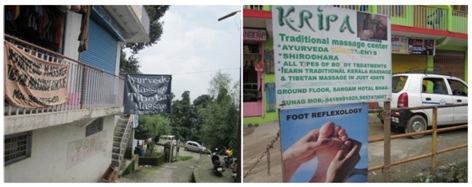
Figure 7: Market driven indigenous health care system.
Commonly found medicinal plants used in stress management at Kangra valley, Himachal Pradesh
| Anti-Stress / Rejuvenator | Factor Loadings | Mean |
| Zingibier officinale Roscoe (Adrakh) | 0.383 | 2.0667 |
| Trigonella foenum graecum L (Methi) | 0.445 | 2.9733 |
| Anti-Allergic | ||
| Phyllanthus emblica L (Amla) | 0.547 | 2.8000 |
| Citrus limon L (Nimbu) | 0.494 | 2.4000 |
| Origanum majorana L (Madwa) | 0.635 | 3.000 |
Table 5: Factor analysis of common herbs for anti-stress (anti - acidity) and anti-allergy.
| Medicinal Plants Species | English Name | Sanskrit Name (in Ayurveda) | Local/Hindi Name | Family |
| Bacopa monnieri L wettst. | Indian penny wort | Brahmi | Brahmi | Scrophulariaceae |
| Phyllanthus emblica L | Emblic myrobalans | Amalaki | Amla | Euphorbiaceae |
| Evolvulus alsinoides L | - | Sankhpushpi | Sankhahuli | Convoluvulaceae |
| Nardostachys Jatamansi DC | Muskroot | Jatamansi | Jatamansi | Valerianaceae |
| Trigonella foenum-graecum L | Fenu greek | Methica | Methi | Leguminosae |
| Withania somnifera dunal | Winter cherry | Aswangadha | Asuagandha | Solanaceae |
| Acorus calamus L | Sweet fig | Vacha | Vach | Araceae |
| Asparagus racemosus willd | Asparagus | Shatamuli | Shatavri | Liliaceae |
| Celastrus paniculatus | Stuff tree | Jyotishmati | Malkangni | Celastraceae |
| Glycyrrhiza glabra L | Liquorice | Yasthimadhu | Mulethi | Leguminosae |
| Tinospora cordifolia willd | - | Guruchi | Giloy | Menispermaceae |
| Eucalyptus globulus labill | Eucalyptus | Tailpatra | Safeda | Myrtaceae |
| Centella asiatica linn | Indian pennywort | Mandukparni | Brahma manduki | Apiaceae |
Pulse diagnosis and purification (Shodhan): an integral part of ayurveda in stress management
Purification or Shodhan is defined as the treatments by which the disease causing factor i.e., imbalance (Doshas) are expelled out of the human body. The impurity and imbalance is removed by its regular practice. This treatment modality is popularly known as Panchkarmaas it consists of following 5 major treatment procedures: namely Basti, Vaman, Virechan, Nasya and Raktamokshan. Nasya treatment includes expelling the vitiated doshas through the naso-salivary secretions. Raktamokshan treatment procedure expels the vitiated doshas by letting of impure blood in small amount from the body. The Panchkarma treatment is reported to be beneficial for the medical tourists of Namlang Himal Health Resort [13,14].
CONCLUSION
The relationship between health and socio-economic aspects is strong. On an average most of the medical tourists spend INR1,500 per day on ayurveda treatment. The total earning of Namlang Himal Health Resort was INR 1,68,000 during peak tourist season. From 25 visitors during October 2015, the resort on an average earned INR 70,000 - 75,000 per day. The stay and treatment cost is also optimal and satisfactory as reported by most of the medical tourists.
Among medical tourists, 90 per cent female mostly in the middle age group are suffering from stress, anxiety or other health issues due to their lifestyle. Single female are more likely to suffer from stress and anxiety due to loneliness, and fear for future. Lack of concentration, loneliness, Insomnia and elevated BP were experienced by 93 per cent, 92 per cent, 90 per cent and 45 per cent of the French tourists respectively. anxiety, frustration, depression, impatience are the emotional stress felt by approximately 45 to 82 per cent of the respondents.
Their lifestyle is highly influencing the health status with late working hour. Irregular diet, fast food, irregular and late night sleep etc., are some of the major lifestyle pattern seen among the patients pre ayurvedic treatment. Several diseases like PNS hypertrophy, Acromegaly, arthritis Parkinson, low immunity and weakness are some major health challenges. Their pre-ayurvedic treatment includes modern high dose medicine. Modern medicine and side effects are interrelated phenomena which were experienced by almost all patients. Long duration of treatment from modern medicine did not provide relief. Post Ayurvedic treatment is a combination of rejuvenation therapy, diet therapy, medicinal plants, yoga, panchkarma and indigenous spa (abhyanga, shirodhara, shodhan etc.,). The diet therapy in ayurveda helps attaining good health which was prerequisite in the treatment. The ayurvedic doctor also reported that about 90 per cent patients (both male and female) release their emotions as a result of the treatment. Patients also reported excellent experience of the treatment which they have never experienced. About 50 per cent reported excellent results and rest reported the treatment as satisfactory. In conclusion, there is good demand from tourists but lack of proper planning in the region is the main bottleneck for untapped tourist location. Medical and adventure tourism in the mid Himalaya region should be promoted by the government and there is an urgent need of lodges, restaurants health resorts and other facilities in the trekking and recreational routes. Working professionals are more susceptible to occupational stress because of intense work load and they are facing with a variety of stress due to long working hours, relationship issues, loneliness and other emotional setbacks. It is recommended that respondents should adapt a positive ways of managing stress by meditating and natural way of life as human beings can manage stress by following healthy lifestyle following ayurveda and yoga.
REFERENCES
- Raghuram Nagarathna (2015) Yoga for life style Diseases. In: International Conference on Yoga for Holistic Health Presentation, 21-22 June. Ministry of Ayush, Government of India, New Delhi, India.
- Liverpool J, Alexander R, Johnson M, Ebba EK, Francis S, et al. (2004) Western medicine and traditional healers: partners in the fight against HIV/AIDS. J Natl Med 96: 822-825.
- WHO (2013) WHO guidelines on conditions specifically related to stress. WHO, Geneva, Switzerland.
- www.ihs.com
- Srinivas H (2001) Environmental impacts of tourism. United Nations Environmental Programme, Nairobi, USA.
- CAM (2020) The contribution of Complementary and Alternative Medicine to sustainable healthcare in Europe. CAM, Europe, UK.
- Goswami N, Singh RB (2015) Herbal Faith Healing Tradition: A spatial Study of Korean Oriental Medicine and Indian Traditional Medicine. In: Sushila N, Kim-Do Y (eds.). Deepening India-Korea relations: towards a sustainable future. Manak Publications Pvt. Ltd, New Delhi, India.
- Welch C (2011) Balance Your Hormones, Balance Your Life: Achieving Optimal Health and Wellness through Ayurveda, Chinese Medicine, and Western Science. Da Capo Press, Cambridge, USA.
- Rajkumar N, Shivanna MB (2012) Traditional veterinary health care practices in Shimoga district of Karnataka, India, Indian Journal of Traditional Knowledge11: 283-287.
- Government of India (2011) Ministry of Health and Family Welfare. Government of India, New Delhi, India.
- Goswami N (2010) Herbal Home Remedies in North-west district of Delhi and Haridwar district of Uttarakhand. M Phil dissertation, New Delhi, India.
- Palletier KR (1979) Sound Mind, Sound Body: A New Model for Lifelong Health. Fireside book, Simon and Shuster, New York, USA.
- Pole S (2006) Ayurvedic Medicine: The Principles of Traditional Practice. Singing Dragon, London, UK.
- Lad V (2012) Textbook of Ayurveda: General Principles of Management and Treatment. The Ayurvedic Press, Albuquerque, USA.
Citation: Goswami N, Singh RB (2017) Health Seeking Behaviour in Stress Management A Case Study of French Tourist Community in Kangra, Himachal Pradesh. J Community Med Public Health Care 4: 024.
Copyright: © 2017 Nitu Goswami, et al. This is an open-access article distributed under the terms of the Creative Commons Attribution License, which permits unrestricted use, distribution, and reproduction in any medium, provided the original author and source are credited.

